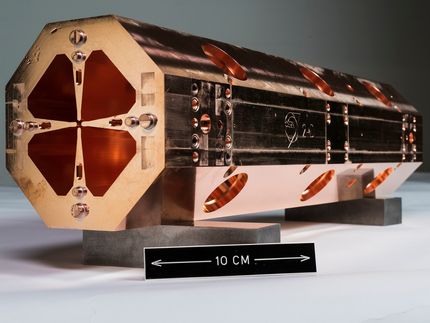Tracking down the beam
Measurement method from Dresden improves accuracy in proton beam therapy
Advertisement
Proton beams are new high-precision weapons in the fight against cancer. However, uncertainty with regard to the range of the beams has prevented the full exploitation of the potential of this method until now. Researchers all over the world are therefore looking for ways to measure the exact range during a course of treatment. Scientists at the National Center for Radiation Research in Oncology - OncoRay and at the Helmholtz-Zentrum Dresden-Rossendorf (HZDR) have succeeded in developing a surprisingly simple solution. Initial preclinical tests have already gone well.

Tumors can be precisely targeted with proton beam therapy without damaging the surrounding tissue. Dresden-based scientists are looking for ways of monitoring the course of the beam in real time in order to increase the reliability of the treatment.
HZDR/AIFilm
A proton beam is similar to a bullet in that it has a certain projectile range. The power of destruction of the charged particles is greatest shortly before they stop. "The effect could be concentrated on a specific point in a human body - in our case on a tumor," explained Dr. Guntram Pausch of the OncoRay center. "In this way it is possible to inflict severe damage on the diseased cells and yet leave the surrounding healthy tissue unscathed." The depth of penetration depends on the initial speed of the beams and the composition of the tissue - and herein lies the challenge, as the radiation expert explained. "Even a trifle like a stuffed nose in the preliminary examination can distort the data for the treatment plan and, later on, this will mean that the beam will not stop right on target. Therefore we have to consider safety margins around the tumor during the treatment."
Up to now it has only been possible to reduce this element of uncertainty with the aid of computed tomography before the treatment or indirectly by assessing the effect of the radiation after the treatment. This is why the Dresden-based scientists are looking for a way to measure the range of the particle beam in real time. Gamma radiation is thought to be a helpful means in this respect. This type of radiation is generated by nuclear reactions triggered by the protons on their journey through the tissue. "The existing methods attempt to measure this gamma radiation using complex and expensive detector systems in order to track the journey of the protons," said Pausch, summarizing the latest research endeavors. "It will take another few years before this can be used in the hospitals." He developed, therefore, together with Dr. Fine Fiedler of the Helmholtz-Zentrum Dresden-Rossendorf and her team an alternative method called "Prompt Gamma Timing". This new method is based on a time measurement for which just one detector is needed.
Rapid identification of nonconformities
The scientists focus on a fundamental physical effect: the protons need a certain amount of time to reach the place where they develop their greatest destruction potential. With the new method they, therefore, measure the time span between the point at which the beam enters the body and the point at which the gamma radiation hits the detector. "If the measured time spectra differ from the ones previously calculated, then the beam does not hit its target with sufficient accuracy," added Pausch. "In this case we would notice this immediately, and could adapt the radiation to the new parameters." In order to confirm their assumptions, the researchers tested the method with the world market leader in proton beam therapy systems, Ion Beam Applications (IBA).
To do this, they went to the West German Proton Therapy Centre in Essen where they treated test objects with proton beams as normally used in radiation therapy. In these experiments the scientists were able to detect deviations of just a few millimeters with their method. On this basis, the safety margins around the tumor could be decreased, the effectiveness of the treatment increased, and at the same time healthy tissue could be still better protected. However, the researchers also studied factors which may limit the accuracy of the method, as Guntram Pausch explained. Nevertheless, he sees great potential for the approach. "As the experiments have shown, our method could be applied in order to rule out appreciable deviations from the treatment plan during the therapy."
Original publication
F. Hueso-González, W. Enghardt, F. Fiedler, C. Golnik, G. Janssens, J. Petzoldt, D. Prieels, M. Priegnitz, K. Römer, J. Smeets, F. Vander Stappen, A. Wagner, G. Pausch; „First test of the prompt gamma ray timing method with heterogeneous targets at a clinical proton therapy facility"; Physics in Medicine and Biology; 2015























































